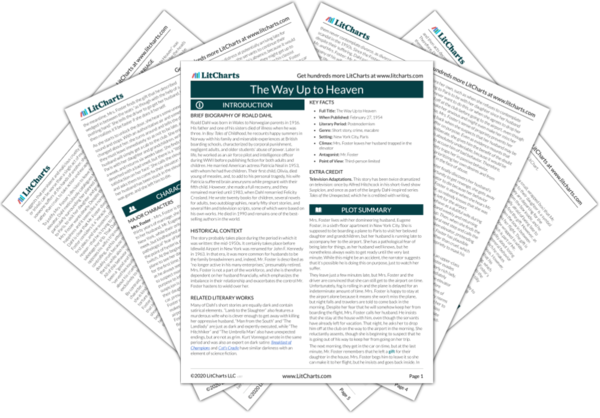Brief Biography of Roald Dahl
Roald Dahl was born in Wales to Norwegian parents in 1916. His father and one of his sisters died of illness when he was three. In Boy: Tales of Childhood, he recounts happy summers in Norway with his family and miserable experiences at British boarding schools, characterized by corporal punishment, negligent adults, and older students’ abuse of power. Later in life, he worked as an air force pilot and intelligence officer during WWII before publishing fiction for both adults and children. He married American actress Patricia Neal in 1953, with whom he had five children. Their first child, Olivia, died young of measles, and, to add to his personal tragedy, his wife Patricia suffered brain aneurysms while pregnant with their fifth child. However, she made a full recovery, and they remained married until 1983, when Dahl remarried Felicity Crosland. He wrote twenty books for children, several novels for adults, two autobiographies, nearly fifty short stories, and several film and television scripts, some of which were based on his own works. He died in 1990 and remains one of the best-selling authors in the world.
Historical Context of The Way Up to Heaven
The story probably takes place during the period in which it was written: the mid-1950s. It certainly takes place before Idlewild Airport in New York was renamed for John F. Kennedy in 1963. In that era, it was more common for husbands to be the family breadwinners and, indeed, Mr. Foster is described as “no longer active in his many enterprises,” presumably retired. Mrs. Foster is not a part of the workforce, and she is therefore dependent on her husband financially, which emphasizes the imbalance in their relationship and exacerbates the control Mr. Foster hastens to wield over her.
Other Books Related to The Way Up to Heaven
Many of Dahl’s short stories are equally dark and contain satirical elements. “Lamb to the Slaughter” also features a murderous wife who is clever enough to get away with killing her oppressive husband. “Man from the South” and “The Landlady” are just as dark and expertly executed, while “The Hitchhiker” and “The Umbrella Man” also have unexpected endings, but are not as grim. Kurt Vonnegut wrote in the same period and was also an expert on dark satire:
Breakfast of Champions and
Cat’s Cradle have similar darkness with an element of science fiction.
Key Facts about The Way Up to Heaven
-
Full Title: The Way Up to Heaven
-
When Published: February 27, 1954
-
Literary Period: Postmodernism
-
Genre: Short story, crime, macabre
-
Setting: New York City, Paris
-
Climax: Mrs. Foster leaves her husband trapped in the elevator
-
Antagonist: Mr. Foster
-
Point of View: Third-person limited
Extra Credit for The Way Up to Heaven
